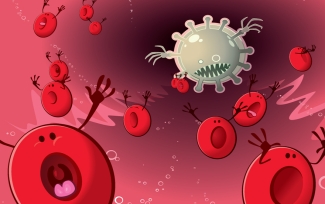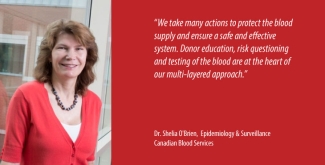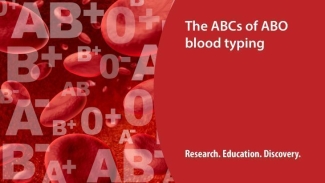What's the risk of infection from a blood transfusion? Dr. Sheila O’Brien knows the answer. She is the associate director of epidemiology and surveillance, working at Canadian Blood Services' head office in Ottawa. Understanding and minimizing the infectious risks associated with blood transfusion is what she does each and every day.
“We take many actions to protect the blood supply and ensure a safe and effective system. Donor education, risk questioning and testing of the blood are at the heart of our multi-layered approach,” explains Dr. O’Brien. “In-depth and timely surveillance of infectious diseases also helps us keep the blood supply as safe as possible.”
How does surveillance work to protect the blood supply?
Surveillance means we monitor transmissible disease testing in blood donations, investigate possible transfusion-transmitted infections in blood recipients (including bacterial infections), and scan the horizon for emerging threats.
We also keep an eye on what blood operators around the world are up to. By learning from others, we can collect even more knowledge, data, and evidence to support changes in policy and process.
We monitor many things over several years to observe trends, discover what questions need to be asked, know what research should be done, and to identify what action should be taken to keep blood as safe as possible and the system operating smoothly and efficiently.
"Staying on top of things is extremely important," says Dr. O’Brien. “This year’s Zika outbreak is a good example of how we were able to react quickly and implement a new deferral in response to an emerging threat.”

Why can risk never be zero?
We do everything we can to keep blood safe, but the risk will never be zero.
Every donation is quarantined and tested before it is approved for distribution to hospitals.
“Established infections are detected when we test the blood,” Dr. O’Brien explains. “However, there is still a short period — called the ‘window period’ — between the time when a donor is infected and when the infection will be picked up by the test. Blood collected during the window period could infect the recipient.”
Years ago, older tests could only detect signs of infection based on the way the body responds to the virus. Newer technology, NAT (nucleic acid testing) for example, can detect the virus itself, even before the body begins to react.
This technology has significantly reduced the window period but it has never been completely eliminated. Because it takes time for the virus to replicate, it is hardest to detect in the first days after infection, but that doesn’t mean it can’t be transmitted. To reduce risk as much as possible, we ask donors many screening questions and implement strict deferral periods following travel or certain activities. These measures help us reduce risk to transfusion recipients as much as possible.
2015 Surveillance Report
- Dr. O’Brien and her team collect their expertise and evidence in an annual report to stakeholders.
- The 2015 Surveillance Report identifies changing trends in known infections and identifies new blood-borne pathogens.
- Donor health screening and education, donation testing, and horizon scanning all work together to ensure a safe and reliable system.
What is residual risk?
Physicians use residual risk estimates to counsel patients about the risk of transfusion. At Canadian Blood Services we use residual risk to monitor the safety of the blood supply, to compare with other countries, and to evaluate our policies. Here in Canada, the current residual risk is very low and comparable with other blood services in developed countries.
The residual risk of infection is the estimated risk of a potentially infectious donation being collected during the window period. For example, in 2015, the estimated residual risk of human immunodeficiency virus (HIV) transfusion-transmitted infection was 1 in 21.4 million donations.
Estimated Residual Risk 2015
|
Human immunodeficiency virus (HIV) |
Hepatitis C (HCV) |
Hepatitis B (HBV) |
|---|---|---|
|
1 in 21.4 million donations |
1 in 12.6 million donations |
1 in 7.5 million donations |
Evidence leading to change
Our constant surveillance helps us to understand infectious diseases and gather evidence of risk to make policy changes that will improve safety and operational efficiency.
Examples of change
- Operational change (change to testing algorithm): West Nile Virus testing was reduced to summer only — when increased risk is present. We are monitoring impact of this change over time.
- Discontinuing the Confidential Unit Exclusion process. This change streamlined the blood collection process, improved system performance without compromising safety and reduced discards by approximately 1,500 units a year.
- Recent reduction of MSM eligibility requirement. This change in policy was made after extensive review of scientific and epidemiologic evidence. Further change will be supported by evidence.

Canadian Blood Services – Driving world-class innovation
Through discovery, development and applied research, Canadian Blood Services drives world-class innovation in blood transfusion, cellular therapy and transplantation—bringing clarity and insight to an increasingly complex healthcare future. Our dedicated research team and extended network of partners engage in exploratory and applied research to create new knowledge, inform and enhance best practices, contribute to the development of new services and technologies, and build capacity through training and collaboration.
The opinions reflected in this post are those of the author and do not necessarily reflect the opinions of Canadian Blood Services nor do they reflect the views of Health Canada or any other funding agency.
Related blog posts
On that front, Canada is doing a very good job. Dr. David Allan, medical director for Canadian Blood Services’ Cord Blood Bank and OneMatch Stem Cell and Marrow Network, reports that more than 1,000 units of cord blood are now available in the public Cord Blood Bank.
It's National Blood Donor Week and we're celebrating blood donors from across the country who make a lifesaving difference to patients in need. Each of us has the right blood type to give life: ABOAB. This acronym refers to four blood groups — A, B, AB, and O. Blood type is one way we are all...

